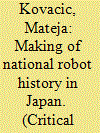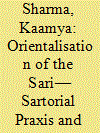| Srl | Item |
| 1 |
ID:
162543


|
|
|
|
|
| Summary/Abstract |
This paper contributes a genealogical perspective to the social sciences study of robots in Japan, proposing a widely applicable research on “robot cultures.” The author discusses the corporate and governmental strategies and mechanisms that are shaping a national robot culture through establishing robot “lineages” and a national robot history which can have significant implications for both humans and robots. The paper contributes discussions on monozukuri (manufacturing) and Nihonjinron (theories on “Japaneseness”) to the existing anthropological consideration of robots, by examining links between monozukuri and robots, robot genealogy, popular culture and robots, and different social rituals and sites that help the enculturation of robots. The paper draws attention to the power relations and hegemonies of robot culture which also imply the existence of plurality and diversity that will require further scholarly attention as the robot phenomenon unfolds.
|
|
|
|
|
|
|
|
|
|
|
|
|
|
|
|
| 2 |
ID:
165930


|
|
|
|
|
| Summary/Abstract |
This article analyses the homologies between colonial knowledge projects and post-colonial revival programmes through Indian textiles and dress. In the nineteenth century, the colonial bureaucracy treated Indian textiles as samples of ‘native’ artisanship, using them to police discourses of race, gender and citizenship. Concomitantly, the nationalist movement created a model of Indian womanhood that conscripted women to be both ‘traditional’ and ‘modern’, signified in the Nivi sari, linking this to emerging craft conservation movements. Post-Independence, elite women became the directors of craft revival by linking sartorial taste to ideal womanhood in a continuation of colonial discourse.
|
|
|
|
|
|
|
|
|
|
|
|
|
|
|
|